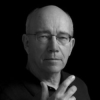Sam Abell

Sam Abell
Sam Abellis an American photographer known for his frequent publication of photographs in National Geographic. He first worked for National Geographic in 1967, and is one of the more overtly artistic photographers among his magazine peers. Sam Abell's style of photography is documentary in the sense that his major avenue, the National Geographic magazine, is a publication of record. However, his best work is known for its transcendent qualities, starting at the documentary level yet open to interpretation on an...
NationalityAmerican
ProfessionPhotographer
CountryUnited States of America
Teaching has never been far from my life. It's the most natural thing I do. Apparently, as I said, I cannot not do it.
It actually has transcended my career at the Geographic, so that when my career there ended, I had momentum as a teacher, and a belief in photographic education at the workshop level.
I can't speak for other photographers, but the photographers who went forward strongly when the so-called "official" part of their career ended, to me, were those who had taught. Teaching enriches and enlivens one's work.
Even though I teach with 35mm, my method takes people by surprise, because it isn't fast, and it isn't about hardware or software, or even great results. It's about great process.
I started teaching in '76 and I'd been a photographer at the Geographic for six years. But prior to being at the Geographic I was a teacher. Plus my parents were teachers and my brother and my grandparents. So it was the culture of our family to think about teaching, to talk about teaching, to talk about teachers.
My parents, grandmother and brother were teachers. My mother taught Latin and French and was the school librarian. My father taught geography and a popular class called Family Living, the precursor to Sociology, which he eventually taught. My grandmother was a beloved one-room school teacher at Knob School, near Sonora in Larue County, Ky.
That statement [ Stephen Ambrose:'You, Sam, have the hardest job, which is, pretend like nothing has happened in the last 200 years.'] woke me up to the fact that the landscape that Lewis and Clark came across was greater than the Serengeti. And it's gone.
Though Geographic didn't publish that photo in the story that it was done for, "The Life of Charlie Russell," a cowboy artist in Montana. But later, maybe a year and a half ago, they named it one of the 50 greatest pictures ever made at National Geographic.
That's who comes to my workshops. I jokingly tell my students that the class could be called "Your photographs: Better."
In the last workshop I taught, a woman flew in from Thailand. She's a medical doctor in Bangkok. I asked her in her one-on-one session where she wanted photography to be in her life.Did she want a second career? Was it about earning money? Or was it art? And she said "None of those. I want photography to be serious in my life." It would be like someone wanting music, like piano playing, to be a richer, deeper, and maybe even harder experience.
Increasingly, it's people not interested in National Geographic.
I was a consultant for Kodak back in the late 80's. There were engineers there who told me that in the future, most photographs would be taken on telephones. They weren't able to do anything with that. They were engineers, not management.
My Dad took a workshop from a photographer who worked at the Toledo Blade, a newspaper I delivered. I knew this photographer's work. My Dad took a night class from him at the University of Toledo. Without that class, I wouldn't have become a photographer, because my Dad came home and taught me what he learned in class.
The class that I teach is called "The Life of a Photograph." It takes up the question, of the billion photographs that were taken today, how many will have a life, and why? So the new reality has made the question more pertinent, not less pertinent.